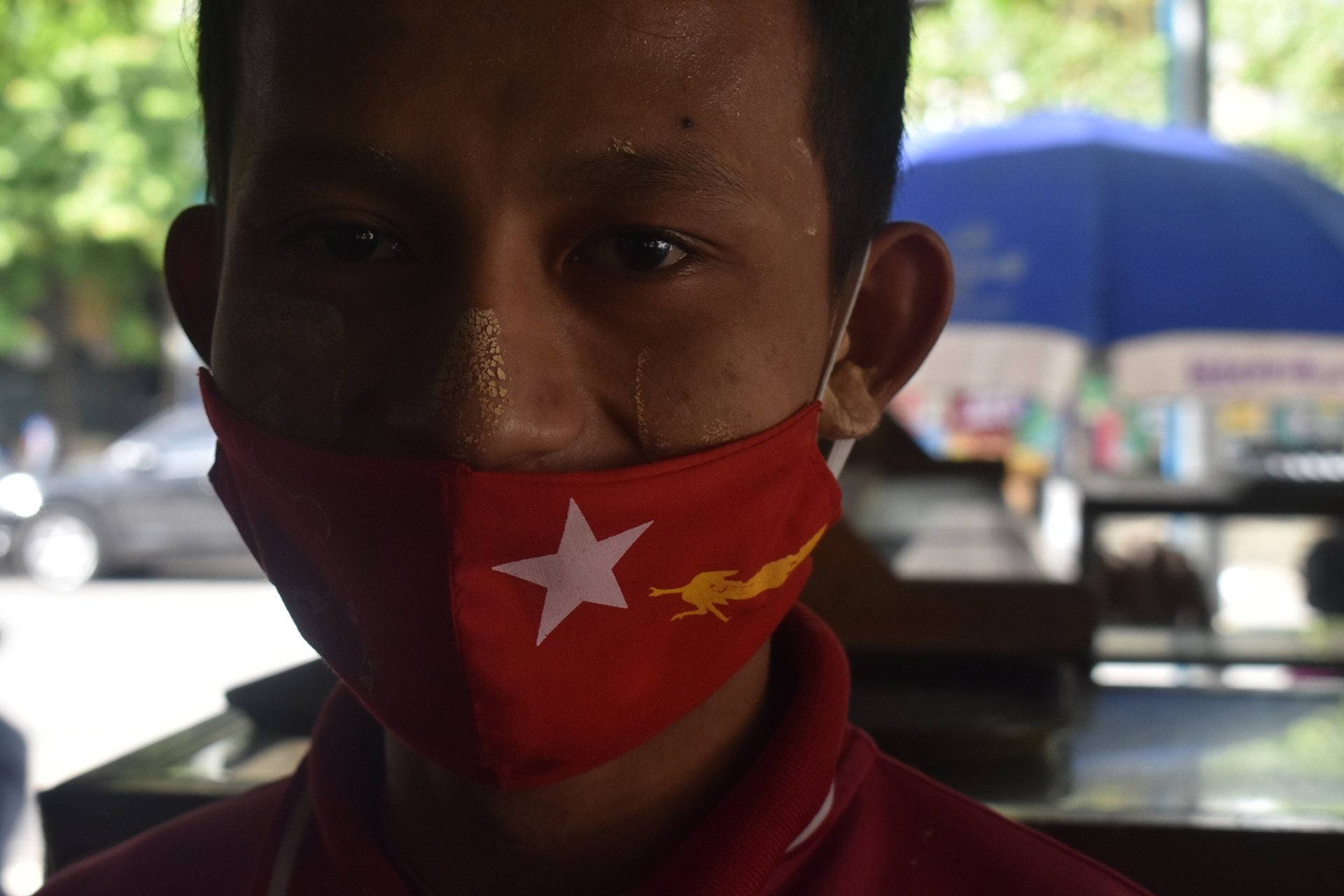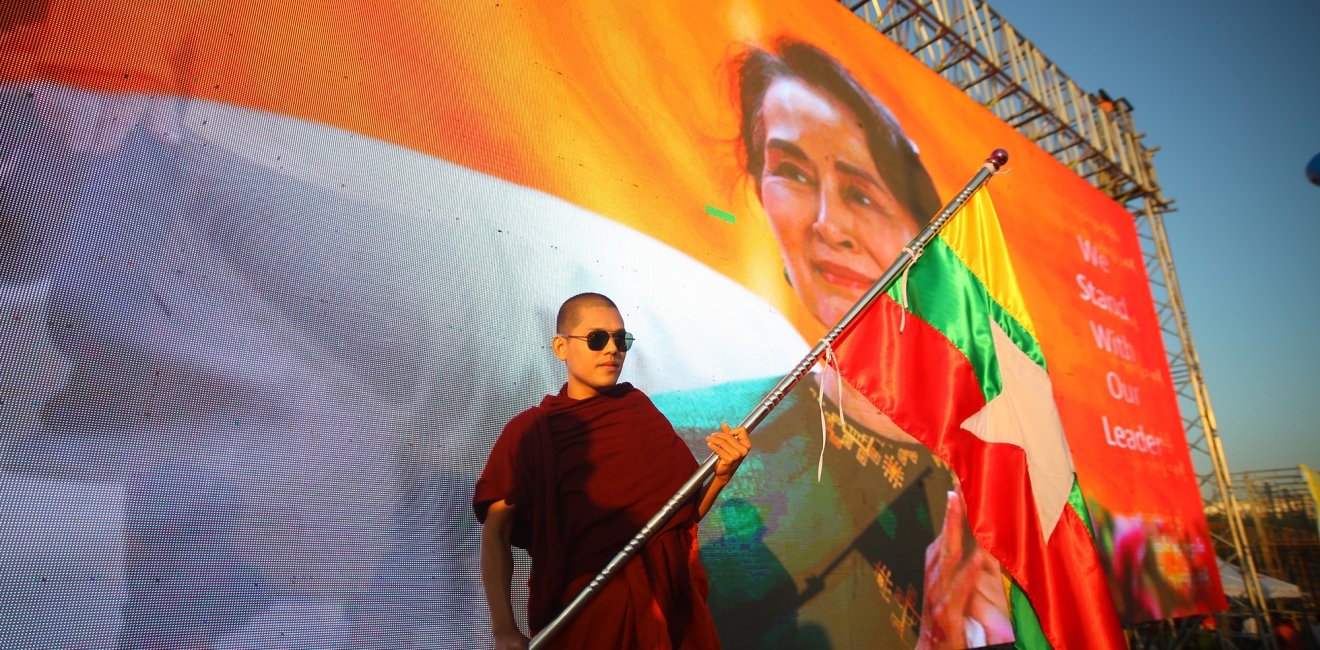
A blog of the Indo-Pacific Program
Although Washington remains fixated on the COVID-19 pandemic and the transition to a Biden administration, Myanmar’s November election also deserves attention due to its implications for the future direction of the nation and as an indicator of the future of U.S.-China competition. The incumbent victory of State Counsellor Aung San Suu Kyi’s National League for Democracy (NLD) reflects their continued resilience and popularity, the country’s halting transition towards democracy, and the likelihood of deepening ties between Naypyidaw and Beijing.
At the geopolitical level, the election in Myanmar underscores the nuanced role that ideology plays in U.S.-China competition. Myanmar’s democracy remains limited and fragile—the military (known as the Tatmadaw) is constitutionally protected and the NLD has cracked down upon its own perceived enemies and independent voices, as well as defended the Myanmar military’s human rights violations against the Rohingya in the Rakhine. However, the recent vote largely reflected the will of the people in spite of Myanmar's highly flawed democracy, a result that demonstrates widespread pro-democracy feelings in Myanmar. At the same time, the NLD is closer to Beijing than it is to Washington despite the United States' interest in supporting democratic transition and a latent anti-China wariness in Myanmar. Overall, due to China’s pragmatic approach to advancing its own national interests, Beijing can safely ignore concerns about democracy or human rights, and Myanmar’s close geographic proximity and relatively weak geopolitical position vis-à-vis China means that Beijing has a degree of leverage the United States cannot hope to replicate, let alone eclipse. These difficulties aside, the United States must still work to adopt a tailored pro-democracy policy in Myanmar that simultaneously fosters Myanmar's flawed democratic transition, counters China's geopolitical objectives, and avoids pushing Naypyidaw further into Beijing's open arms.
The NLD’s Victory and Its Impact on Myanmar
On November 8th, 2020 the electorate largely embraced the country’s nascent democratic transition, but complexities remain that challenge easy characterizations. The incumbent NLD received a large majority of parliamentary seats in the November 8th vote—397 seats in a 476-seat parliament. This earns the NLD a majority even larger than their original victory in the 2015 election. On the other hand, the military-aligned party, the Union Solidarity and Development Party (USDP), lost over half its seats. This failure demonstrates their unpopularity, and the clearly-chastened USDP recently issued challenges to the Supreme Court alleging fraud. The extent of the victory is such that the NLD expanded its support among minority ethnic voters. The historically Bamar-dominated NLD had been unpopular in ethnic minority-dominated regions as a result of its lack of progress on federalism, or local autonomy in this context, and even suffered a stark electoral blow in the 2018 mid-term contests. As such, it is clear that many in Myanmar continue to view the NLD as the nation’s best hope for further democratic progress, constitutional reform, and the long-stalled peace process.
Even so, the success of Myanmar’s nascent democratic transition does not mean that the country embraces a liberal form of democracy. Following the 2011 launch of its democratic reform process, Myanmar instituted some elements of electoral democracy while also remaining quite illiberal in terms of political and social rights. Indeed, the country’s democratic prospects remain haunted by the military’s constitutional privileges. Despite the NLD’s victory, the military maintains its legally-mandated permanent 25% of seats in parliament. With these guaranteed-seats, the military and the USDP hold just enough seats to veto any NLD-proposed constitutional amendments aimed at weakening their role in government. Furthermore, the Ethnic Armed Organizations (EAOs), some of which allegedly receive arms and influence from China, continue to engage the Tatmadaw in combat.
Beyond the Tatmadaw, the NLD’s own record on the liberal aspects of “liberal democracy” is quite poor. Fighting in outlying states and regions led the central government’s election commission to cancel voting in 17 Rakhine State townships, one of the few regions in which the NLD consistently lacks dominance in the state-level legislature. Perhaps not coincidentally, this region’s locally-dominant Arakan National Party expected to perform well. The NLD also continues to vocally support the Tatmadaw’s campaign against the Rohingya, and it even prevented three ethnically-Rohingya politicians from running in the election. Furthermore, the government arrested numerous journalists and students throughout its first term. Hopes in the West and among pro-reform activists in Myanmar for Aung San Suu Kyi’s NLD to embrace liberalism as well as democracy have been dashed for several years.
Given its mixed record, the current NLD victory can best be interpreted as a “lesser of two evils”-style choice. With the military widely opposed, many voters in Myanmar view the NLD—despite its flaws—as the best hope for continuing democratization. Moreover, many ethnic minority citizens identify democracy and the sidelining of the Tatmadaw as prerequisites to long-desired autonomy under a federalist system. Furthermore, outside observers should recall that regardless of the outcry in the West, the repression and violence faced by the Rohingya are not viewed negatively by the populace at large. Thus, the resounding NLD victory should therefore not be seen as a strict win for liberal democracy, but instead as a reflection of the complicated nature of Myanmar’s flawed constitutional system and the illiberal impetus within the NLD leadership.
China’s Position in Post-Election Myanmar
Given expanding great power competition, Myanmar’s election also carries implications for the region’s geopolitics, and the NLD government will face questions as to its position in the U.S.-China rivalry. Strategically located at the intersection of China’s southwestern Yunnan Province, Bangladesh, India’s eastern states, ASEAN’s western flank, and the increasingly contested Indian Ocean, Myanmar’s choice of government matters for geopolitics. While Myanmar may hope to strike an independent balance in a tough neighborhood and conduct outreach to powers in the West, China looks set to make relative gains, and the United States will have scant opportunities to offset its growing deficits vis-à-vis China in Myanmar. Seemingly paradoxically, the democratically-elected NLD government continues to value warm, but balanced, ties to Beijing.
Beijing for its part also values strong ties to Myanmar. China may have waited over a week to congratulate Aung San Suu Kyi, but Beijing’s patience does not reflect a preference for the military. Instead, China’s views demonstrate its pragmatism. Reports indicate that Chinese leadership preferred the NLD to win reelection, and some in the military-aligned USDP vocally adopted anti-China rhetoric during the election. In initially waiting to recognize the NLD, perhaps Beijing hoped to avoid antagonizing the Tatmadaw while the USDP criticized the results, similar to how it behaved after the 2020 U.S. election. In either case, Xi Jinping eventually issued a letter congratulating the NLD and touching upon its major concerns: “[Xi] called for concerted efforts to promote practical cooperation in various fields within the frameworks of the Belt and Road Initiative and the China-Myanmar Economic Corridor, maintain peace and tranquility in the border areas, and push for a fruitful China-Myanmar community with a shared future.”
China stands to benefit most from the NLD’s victory by further entrenching its already extensive involvement in the country. Governed by its need to secure access to the Indian Ocean and Middle Eastern oil through the over land Yunnan-Myanmar route, China-Myanmar relations are highly complex. China simultaneously supports EAOs, shepherds the peace process, serves as a major investor under the Belt and Road Initiative’s China-Myanmar Economic Corridor (CMEC), and actively engages the NLD’s democratically-elected government. Beijing hopes to balance anti-Chinese sentiment in Myanmar with the NLD’s need for international cover in the Rakhine and economic development. For the NLD, this Chinese cover grows increasingly vital as the West and its investors express concerns over the Rohingya issue. Going forward, we can expect China to try and take advantage of its positive ties to the NLD to advance CMEC with the ultimate goal of enshrining an overland route from Yunnan to the Bay of Bengal.
Key opportunities for entrenchment hinge on China’s unique value adds for Myanmar. Although anti-China sentiment is widespread in Myanmar, the NLD needs China to accomplish many of its own goals. As criticism of human rights violations increases and possibly expands under a Biden administration, China can continue to provide crucial diplomatic cover for Myanmar in the United Nations. Recently, two Tatmadaw soldiers confessed on video to killing Rohingya villagers in 2017 and were brought to The Hague amidst ongoing proceedings between Bangladesh and Myanmar in the International Criminal Court (ICC). Additionally, Myanmar and China face similar novel legal challenges in the ICC over their Rohingya and Uighur crackdowns. On the domestic front, the NLD issued a post-election public letter to 48 ethnic political parties calling for a renewed peace process as an early priority in 2021. Considering China’s strong influence over several insurgent groups, such as the United Wa State Army, Beijing could position itself to advance the peace process. Finally, public blowback may have stymied the Myitsone Dam, but China will continue expanding Myanmar’s strategic infrastructure to draw the NLD further into its economic orbit.
That said, these are long-term goals unlikely to be accomplished within the next five years of NLD governance. Indeed, China’s current strategic position in South and Southeast Asia at large is relatively fragile compared to India and the United States, particularly regarding power projection. However, firmly entrenching the BRI and CMEC against earlier domestic pressure, assuaging Myanmar’s concerns over China’s influence, minimizing cross-border instability, and preventing the United States from making inroads will ensure continued Chinese influence in Myanmar and a strong access point to a contested region.

A Longer-Term Outlook for America’s Myanmar Policy
From the American perspective, Myanmar policy lacks a clear path forward. Aung San Suu Kyi is increasingly persona non grata in the West as human rights violations continue against the Rohingya in Rakhine State. At the same time, the NLD are indeed popularly elected and their success can partially be seen as the culmination of the Obama administration’s first-term efforts to support democratic transition in Myanmar. Complexity or no, Chinese influence in the region is increasing incrementally, and U.S. policy attention will be necessary to avoid China acquiring undue influence in a strategically important sub-region of the Indo-Pacific.
Recent American attempts to peel Myanmar back from China reflect how these complexities in Myanmar’s position do not bode well for the future of U.S.-Myanmar relations. In July 2020, George N. Sibley, the Charge d’Affaires at the U.S. Embassy in Myanmar, published an op-ed in The Irrawaddy—a publication in Myanmar—criticizing China. The piece argued that China’s assertive international actions in the South China Sea and influence in Myanmar under the BRI undermine the nation’s sovereignty and economic health. The Chinese embassy struck back quickly, engaging in a brief verbal fight that accused the United States of unjustly criticizing China. Although many Burmese would likely agree that Chinese influence is problematic, the linkage of the South China Sea to Myanmar’s sovereignty is unlikely to be persuasive to an underdeveloped country dependent on its larger neighbor for investment, especially when that neighbor has a long history of meddling in Myanmar.
As an alternative to heavy-handed rhetoric, the United States should bet on longer-term time horizons—as China has—by supporting democratic transition, working with the NLD where it can, providing greater development assistance, and advocating for the rights of persecuted ethnic minorities. Beyond the NLD, the United States can help support alternative pro-democracy political parties, oppressed ethnic minorities, and civil society by expanding its already extensive USAID and State Department development projects and democracy initiatives. Over the long-term, building the capacity of ethnic minority groups and civil society organizations can help ensure a democratized Myanmar where more liberal pro-democracy political parties can compete effectively at the national level against the military establishment. In such a Myanmar, the widespread anti-China sentiment within the populace might also be reflected electorally to American advantage. At the same time, given the NLD’s current dominance, the Biden administration will have to engage the government on issues of mutual interest.
However, working with the NLD presents a moral dilemma and balance is key. The United States should both stand up for its values by supporting the Rohingya and other minorities, while also not push Myanmar further into China’s arms. The Tatmadaw and its unpopularity may hold the key to this balance. U.S. policy towards Myanmar should work to separate the NLD from the Tatmadaw on issues such as the Rakhine human rights violations. As the USDP’s rejection of the election results reminds us, the Tatmadaw looms large over Myanmar’s nascent democratic institutions and could leave the barracks to roll back human rights and democracy to a greater extent than Aung San Suu Kyi has. In order to foster democracy in Myanmar, the United States will need to deftly work with the NLD on governance capacity building, development, and reform. Sanctioning the Tatmadaw separately from the NLD was a good start, but the NLD clearly views its interests as tied to the military’s on this issue and opportunities for walking this policy tightrope will be fraught.
From the perspective of great power competition, the United States’ other opportunities—albeit limited ones—to directly address China’s influence in Myanmar lie in targeting Beijing’s competitive advantages. Greater economic and development investments and efforts to foster the peace process in support of the NLD can partially offset China’s dominant position on those issues. To be sure, China will likely always outweigh the United States in both areas. However, the Biden administration should attempt to provide an alternative to Beijing with a tailored approach that engages the key actors, particularly ethnic minority parties and Myanmar’s nascent private sector. The United States could also work to support the NLD in its constitutional reform efforts and initiatives to demilitarize the civil service, such as its 2018 changes to the General Administrative Department. Overall, the goal here is not to align Myanmar with the United States or ask it to reject China wholesale. Instead, the aim is to neutralize Myanmar and prevent it from becoming a close partner of China in the vein of Pakistan or Cambodia.
What the Myanmar Election Underscores About U.S.-China Competition
Beyond the NLD’s victory, the growing ties between Myanmar’s democratically-elected NLD and China demonstrate the pragmatism of Chinese leadership and the realpolitik that complicates the “democracy versus authoritarianism” view of U.S.-China relations. Just as the United States enjoys close ties to non-democratic regimes in countries such as Saudi Arabia and the United Arab Emirates, China can be close to more mixed regimes as well. When China’s national interests are at stake, Beijing will engage pragmatically. Local context matters for alignment, and the incoming Biden administration should not expect the NLD—democratically elected or not—to alienate or openly reject Beijing. Myanmar and China have too long of a history and too close of a border to do so, regardless of whether Naypyitaw hews authoritarian or democratic. On a wider scale, the United States should be careful to avoid forcing countries in South and Southeast to choose sides, as China’s economic dominance and proximity will complicate the calculations of regimes dependent on Beijing’s investments and concerned about its wrath. Instead, a longer time horizon and tailored policies suited to each country’s interests and concerns can at least advance neutrality in the U.S.-China competition. In this case, a Myanmar that does not find itself beholden to China and a CMEC that remains incomplete would constitute a strategic victory.
Follow the Asia Program on Twitter @AsiaProgram. or join us on Facebook.
The views expressed are the author's alone, and do not represent the views of the U.S. Government or the Wilson Center. Copyright 2020, Asia Program. All rights reserved.
Author


Indo-Pacific Program
The Indo-Pacific Program promotes policy debate and intellectual discussions on US interests in the Asia-Pacific as well as political, economic, security, and social issues relating to the world’s most populous and economically dynamic region. Read more





